SUBJECTS
GRADE
Show Results
Paiute Federal Recognition & Sovereignty Dance
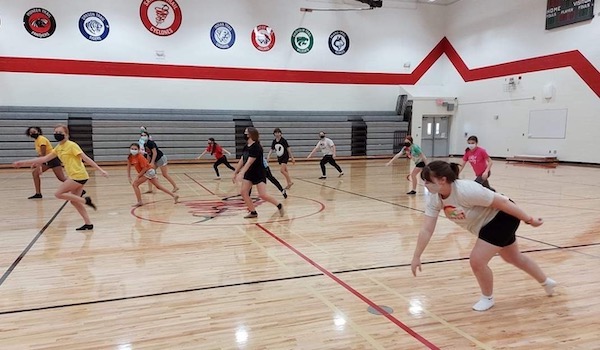
Lesson Summary
- Learn choreography that will access students’ largest kinesphere.
- Learn about the history of the Paiute Indian Tribe of Utah.
- Choreograph movement inspired by the Paiute's past and present.
Lesson Plan and Procedure
Lesson Key Facts
- Grade(s): 6, 7, 8
- Subject(s): Dance, English Language Arts, Social Studies, Native American, Tribe Approved
- Duration of lesson: 90 minutes or two 45-minute sessions
- Author(s): Dorena Martineau and Lauren Evans
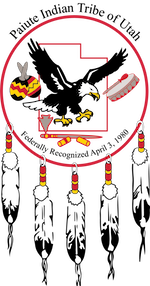
The Paiute Indian Tribe of Utah’s Tribal Council selected this lesson content in answer to the question, “What would you like the students of Utah to know about you?” Dorena Martineau, the Paiute Cultural Resource Director, represented the Paiute Indian Tribe of Utah in crafting the lesson to provide expertise, accuracy, and authenticity. The lesson was then approved by the Paiute Indian Tribe of Utah’s Tribal Council.
Before teaching this lesson, please explain to your students that there are many Indigenous tribes in the United States and that this lesson specifically focuses on the five bands of the Paiute Indian Tribe of Utah and does not represent other Native American groups. It is the hope of the Paiute Indian Tribe of Utah that other Native tribes will respect their choice to share these aspects of their history and culture.
This lesson teaches and encourages students to create modern creative dance movement. The movement in this lesson does not imitate traditional Paiute dances. Teachers should not mimic or recreate Native dances. The essence of this lesson is to embody the restrictions placed upon the Paiute tribe and celebrate their many and great accomplishments.
Note: If you plan to split the lesson into two 45-minute sessions, an appropriate breaking point is at the end of the choral reading and before the explore tribe vs. band.
Preparation Before Lesson
- For the Hook/Intro, print off the attached documents, cut each cell, and put pieces of paper into a bowl/hat.
- Using painters’ tape, tape a large outline of the state of Utah encompassing the entire room.
- Print off the choral reading for each student in the class and the teacher
- Print “Paiute Bands Tableau Information”
Hook/Intro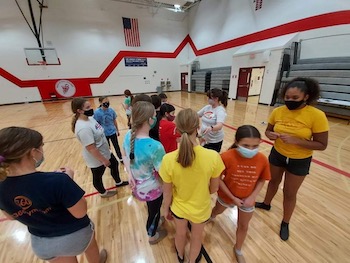
Teach students choreography involving their largest kinesphere. Make sure the students understand what it means to move with their largest kinesphere. (See additional resources for information about kinespheres.) Then in preparation for the class you will have printed out the google docs attached in the “Preparation” section and cut out each cell in the tables included in these documents. After cutting out the cells, put each piece of paper in a bowl. These pieces of paper will be referred to and represent restrictions.
After students know the choreography well, students will each draw 1 restriction randomly from the pieces of paper available. They will not be able to access whatever is on their paper. For example, if a student draws a piece of paper that says “arms” then they will perform the taught choreography to the best of their ability using their largest kinesphere but without using their arms. Students may keep each piece of paper they draw.
Invite each student to pick another restriction paper and then split the class into two groups. Invite both groups to perform for one another with both the restrictions they have drawn so far. Ask the students to notice the ways that their peers perform and solve problems with the restrictions. Repeat this process so students are performing for each other again with three restrictions.
Reflection
After all the students have performed three restrictions, it is time to reflect on what this experience was like. Some questions you can ask are:
- What was this experience like?
- What was difficult about this activity?
- What was easy?
- How did you feel once a restriction was placed upon you?
- Have you had restrictions placed on you that have hindered your ability to live in your “largest kinesphere”?
- What did you like about another peer’s performance?
- What were the similarities or differences between your peers’ methods of solving the problem of moving with the restrictions they were given?
Teacher: Likewise, many groups of people throughout history have felt unseen, due to the policies enacted by people in power, silencing their voices. Today we are going to learn about a group of Native American people, the Paiute Indian Tribe of Utah, who for 26 years were forgotten and confined until 1980 when their federal recognition was restored. Does anyone know what it means to lose federal recognition as a Native American tribe?
Explain that when a tribe loses federal recognition it means that reservation land is no longer protected under trust agreements with the United States. The tribe does not have federal tax protection, health and education benefits, or agricultural assistance. Recognition stems from treaties signed with the Federal government in years past. In essence, “lost,” means the treaties are no longer recognized, therefore the tribe is not considered a tribe or sovereign nation.
Share that in 1954 four Paiute bands in southwestern Utah lost their federal recognition. For 26 years they were without any federal assistance or recognition. They lost approximately 15,000 acres of land and nearly one half of the Paiute people died because of inadequate health resources.
Teacher: In comparison, the home you live in cannot be taken by somebody else as long as you adhere to certain rules, such as paying rent or mortgage. If you are following those rules then the federal government recognizes that you live in that property and provides legal protection. The Paiute tribe was following the rules, but even though they were, the federal government told them that they were not going to provide that legal protection against their land anymore. Therefore, they were not given many of the benefits that we enjoy and need such as healthcare or education.
Choral Reading
Pass out the choral reading about the history of the Paiute Indian Tribe of Utah’s lost and restoration of recognition and sovereignty (see attached PDF). Choral reading is an interpretive reading of text by a group of voices. Students may read individual lines or stanzas alone, in groups or in unison as a whole class. Since the Paiute tribe contains five bands today, arrange the class into five groups. These will be the small groups in the choral reading and the solos will be five individual narrators, one from each group.
Have each group choose their narrator or select a narrator from each group yourself.
The teacher should do the initial reading. This will set the pace and model proper pronunciation for students as they listen. After the first reading, have the students do the choral reading all together as a class.
Discuss and ask questions like those below:
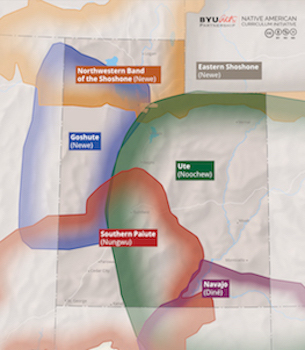
- What are your initial feelings about what we read?
- How do you think the Paiute tribe felt about losing federal recognition and sovereignty?
- In contrast, how do you think they felt when they regained it?
- Now, knowing what it means to lose federal recognition and sovereignty, how would you feel if this happened to you?
NOTE: If this is a two-part lesson, this is a good place to stop.
Exploring Tribe vs. Band
Show the class the historical map of Utah Native tribal lands and point out the traditional Southern Paiute territory.
Ask if any students have been to this region of Utah. Have them share what the climate was like, what they noticed about the physical geography, and any other distinguishing factors. Write their answers on the board. Consider creating a mind map.
Then read aloud the facts below about the Paiute. Remind the students that some of these facts refer to the Paiute way of living in the past before settlements were founded in the area. Write abridged versions on the board and have a discussion with the students, drawing connections, recording questions and so on.
- The Paiute people refer to themselves as “nungwu” (NOONG-WOO), which means “the people”.
- Paiutes were also nomadic hunters and gatherers. The Paiute traveled to various areas throughout the year to harvest food and natural materials in the appropriate seasons.
- Many Paiute lived in wickiups. Wickiups are small round or mound-shaped houses made of a willow frame and covered with brush.
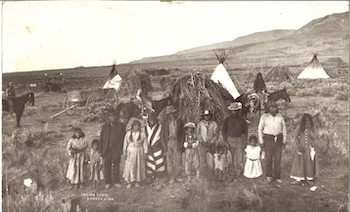 Here is a picture of a wickiup from the Kanosh band. The wickiups pictured here were used for families to reside in. Although not pictured, the Paiute tribe also had smaller wickiups that were used for shade to keep cool.
Here is a picture of a wickiup from the Kanosh band. The wickiups pictured here were used for families to reside in. Although not pictured, the Paiute tribe also had smaller wickiups that were used for shade to keep cool.- Wickiups were easily portable.
- Their economy consisted mostly of trade. They would trade with surrounding tribes. Everyone, all individuals from all families, participated in trading anything from foods, seeds, baskets, horses, mountain sheep, salt, paints, arts, and crafts. They continue to trade today.
- Southern Paiutes were a peaceful people; they did not go into warfare unless they had reason to. Certain bands would join with the Utes or other neighboring tribes or bands if they needed help.
- Paiute are known to be excellent basket weavers. They would make baskets for water jugs, carrying pine nuts, and food. They would use willow fibers and sumac fibers to make the baskets.
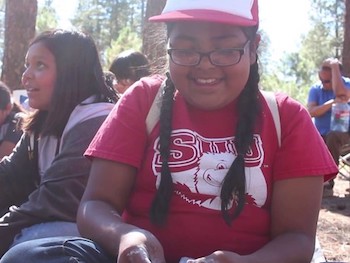 Here is a picture of Paiute youth today. We especially want to highlight that the Paiute exist and thrive as a nation today.
Here is a picture of Paiute youth today. We especially want to highlight that the Paiute exist and thrive as a nation today.
After reading the facts, and writing them on the board ask, “What movement qualities could be inspired by the way the Paiute tribe lived?” Below is an example that could help your students begin to brainstorm:
- Because the Paiute often utilized trade as their source of economy, discuss what movement properties come to mind when students think of trade. I think of core-distal movement and movement that spreads throughout the entire space in any locomotor pattern.
Write the discussion answers on the whiteboard.
The Paiute Indian Tribe of Utah today is made up of five bands. A band is a much smaller group of people, mostly related. In comparison, a tribe is a larger group, sometimes comprised of smaller bands, which share a language along with basic customs and beliefs.

Hold up a map of Utah with the following towns/counties highlighted. Point to the corresponding towns as you watch Karma Grayman share part of a legend about the five bands at https://www.youtube.com/watch?v=cJw7ZfE2UkI&list=PLQ_aOwP41-h5iLbUkn3owO9vdhvS3cEVJ&index=8. (View from 18:20-20:30)
Teacher: In the video, Karma Grayman, a Paiute elder, taught Paiute children about the five bands of the Paiute tribe. Raise your hand if you have been to any of these counties before:
- Iron County, Cedar City, this is where the Indian Peaks Band lives
- Iron County, Cedar City, this is where the Cedar Band lives
- Sevier County, Richfield, this is where the Koosharem Band lives
- Millard County, Kanosh, this is where the Kanosh Band lives
- Washington County, this is where the Shivwits Band lives
Note: There is a phonetic pronunciation guide for these Paiute band names at the end of the choral reading.
Divide the class into 5 groups and assign each group in secret (other groups will not know) a movement characteristic from the ones your class discussed about the Paiute tribe. Give each group 5 minutes to choreograph 8 counts of movement based on the movement characteristics they were assigned. Students may spread out throughout the entire room to work on the choreography. After the 5 minutes students will perform their choreography in the SW corner of the room (representing the Paiute Indian Tribe of Utah) and the students watching will have to guess which movement characteristic they are performing. Summarize this activity with this question…
What did you learn about tribes and bands and the ways the Southern Paiute tribe lived within their environment?
Instruction/Rehearsal
Have the class sit in their five groups. Hand each group one description paper for either the Cedar, Indian Peaks, Kanosh, Koosharem, and Shivwits band (print and pass out “Paiute Bands Tableau Information”). Give them 5 minutes to practice reading the information aloud and making the logo with their bodies through a shape. Students may choose whether to make the same shape in their group or each make a different shape. They do not need to read the contact information on the documents. Gather the class together and have them continue to sit in their bands as the groups perform their still shape for each other in the SW corner of the taped UT state.
Activity/Performance
Create a Modern Creative Dance inspired by Paiute Bands
The students are now at the create and perform portion of the class. Together as a class, students will create one big, choreographed dance through combining the movement they have learned and created thus far. The structure of the big group dance will look like this:
- As a class, students will perform the original large kinesphere combination they learned without any restrictions. Make sure students perform this close to the other peers in their band groups.
- Then, one by one, each band will start to experience restrictions being placed on them, representing them losing federal recognition and sovereignty. Each band will start to perform the original choreography but add restrictions such as performing the choreography without arms, just as they did in the first activity. This movement should not be new to them.
- The bands continue to perform this restrictions choreography until all, but one band has left the stage.
- The one band that is left will perform their 8 counts of choreography they created, twice. They will end with the shape they created inspired by the band’s logo.
After the first band has performed their choreography, they will exit the stage, and another band will enter. This will repeat until all bands have performed the choreography from step 4.
Each band group will need to choreograph a way to enter and leave the stage continuing to be inspired by the movement they created within their band.
- After all band groups have performed their choreography, the teacher will choreograph a way for all the students to come back on stage.
- After all the students are back on the stage, they will perform the original movement they performed at the beginning of this dance, without the restrictions. Making sure they are embodying how it felt for the tribe to receive federal recognition and sovereignty once again.
- All together as a class they will need to create an ending shape. Here is the activity to help inspire movement for this ending shape…
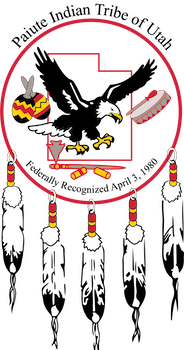
As the students and teacher explored the restoration phase of Paiute history, they showed the tribal nation’s restored sovereignty. The Paiute tribe were able to govern themselves through their recognized tribal council. The separate bands joined together to create the unified Paiute Indian Tribe of Utah. Here is a picture of the Paiute Indian Tribe of Utah logo.
Have the students create an entire class shape. This will not be a shape of the Paiute Indian Tribe of Utah logo, but will instead show how the Paiute people felt as they were again granted federal recognition. To do this, instruct students to physically move together and create a frozen picture symbolizing the individual bands joining together to form one federally recognized tribe. The class should decide their movement based on the feelings the Paiute people might have felt at this time. All the bands will need to work together and be ready to create the shape in fifteen seconds.
Conclusion
This ending shape the class creates is the end of the performance. After they perform the piece a couple of times lead a cool down, then discuss what it was like to embody the feelings and emotions of the Paiute tribe losing and regaining federal recognition and sovereignty. Some questions you could include in your discussion are…
- What is a word or phrase that shares your main take-away from what you have learned about the Paiute Indian Tribe of Utah?
- Why is that idea important for us today?
- Does having federal recognition mean that everything is perfect and easy for the Paiutes? Why or why not?
- How did the movement activities help you better understand and relate to these real experiences, both in the past and present, of the Paiute people?
- How might these activities and knowledge affect you in the future?
- What was challenging about the performance? What was easy?
- What were the feelings you had when performing this piece you created?
Learning Objectives
- Explore losing and regaining federal recognition.
- Working in collaborative groups to create movement.
- Learn and explore the history of the Paiute Indian Tribe of Utah and create dance inspired by this newfound knowledge.
Utah State Board of Education Standards
This lesson can be used to meet standards in many grades and subject areas. We will highlight one grade’s standards to give an example of application.
Grade 6 Dance
- Standard 6.D.CR.2: Use a variety of stimuli and solve multiple movement problems to develop unique choreographic content.
- Standard 6.D.CR.3: Develop a dance study that communicates personal or cultural meaning.
- Standard 6.D.P.1: Build partner and ensemble skills by demonstrating effective spatial relationships with diverse pathways, levels, and patterns in space.
- Standard 6.D.P.7: Collaborate as an ensemble to refine dances by identifying what works and does not work in executing complex patterns, sequences, and formations.
- Standard 6.D.R.2: Interpret artistic intent and use criteria to critique a dance and explain what the movement communicates.
- Standard 6.D.CO.1: Discuss how the experience of creating and sharing a dance reinforces personal views or offers new knowledge and perspective.
- Standard 6.D.CO.3: Interpret and show how the movement and qualities of a dance communicate its cultural, historical, and/or community ideas and perspectives of the culture, historical period, or community purpose or meaning.
Grade 6 English Language Arts
Standard 6.SL.1: Participate effectively in a range of conversations and collaborations on topics, texts, and issues.
- Respectfully acknowledge comments, claims, and evidence from multiple perspectives and identify contradictions when applicable.
- Participate in conversations by posing questions, acknowledging new information, qualifying or justifying responses with reasoning and elaboration, and keeping the discussion on topic.
Grade 6 Social Studies
- Standard 6.4.3: Determine how human rights and responsibilities around the world have developed over time, and identify ways individuals and organizations work to protect rights considered essential for all humans.
Equipment and Materials Needed
- Painter’s tape
- List of restrictions for Hook/Intro portion of the lesson
- Paiute Bands Tableau Information
- Choral reading
- Scissors
- Large hat/bowl to put the list of restrictions in
- Map of historical Native lands in Utah
- Image of Paiutes in front of wickiups
- Image of Paiute youth today
- Map of Paiute Indian Tribe of Utah reservation lands
- Paiute Indian Tribe of Utah Logo
- Music: You may choose the music that you wish for your students to use. Below are a couple of examples of music from Native artists that would enhance the lesson:
- Recording of Paiute flute music https://www.youtube.com/watch?v=w3ZcO9McKyY&list=OLAK5uy_muPHn76l3IOPkTt_ceVwrEmyjl01IQIqg&index=1
- Connor Chee is an accomplished Navajo pianist. You could look up music from him to use in the lesson
- Sunrise (from Scenes of Dinetah) by Connor Chee https://www.youtube.com/watch?v=Zc6x-Piy6eM
- Sunrise (from Scenes of Dinetah) by Connor Chee https://www.youtube.com/watch?v=Zc6x-Piy6eM
Additional Resources
This lesson was created thanks to a grant from the National Endowment for the Arts and the Utah Division of Arts & Museums.
- Paiute Indian Tribe of Utah’s website
- Here are 3 videos that give insight into tribal sovereignty and treaties. Feel free to view these to further your own understanding and edification.
- Washington Tribes explain tribal sovereignty
- BESE Explains: Tribal Sovereignty
- Why Treaties Matter | NPR
- If students are having a hard time accessing their largest kinesphere, this video from 0:00-1:19 is a great example of someone accessing their largest kinesphere and of someone explaining the concept of kinesphere.
- This is an elementary drama lesson written by Haley Flanders Anderson and Emily Soderborg about Paiute Federal Recognition and Sovereignty for grades 3-6. The “choral reading” and “Paiute Bands Tableau Information” were created by these educators and should be credited as such.
- National Parks Service Curriculum Guide, includes links to useful resources about the Southern Paiute culture.
Image References
Image 1: Beth Dean
Image 2: Paiute Indian Tribe of Utah
Image 3: Beth Dean
Image 4: Curtis Soderborg
Image 5: Indian Camp, Kanosh Utah by George Edward Anderson, L. Tom Perry Special Collections, Harold B. Lee Library, Brigham Young University https://contentdm.lib.byu.edu/digital/collection/GEA/id/3015
Image 6: https://www.youtube.com/watch?v=XusETrEjeOE&t=193s located at https://www.utahpaiutes.org/culture/
Image 7: Curtis Soderborg
Image 8: Paiute Indian Tribe of Utah
© Brigham Young University and Paiute Indian Tribe of Utah

www.education.byu.edu/arts/lessons
 Download
Download